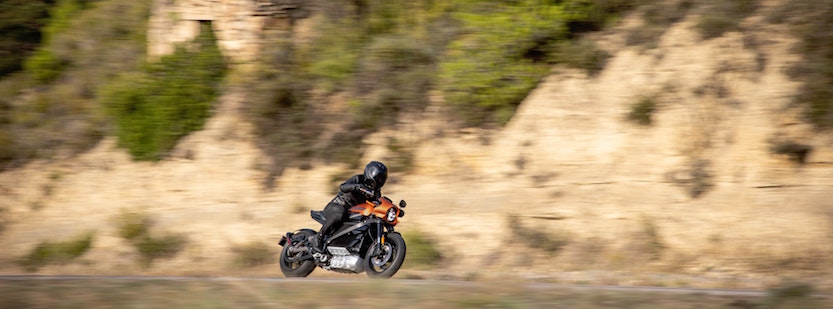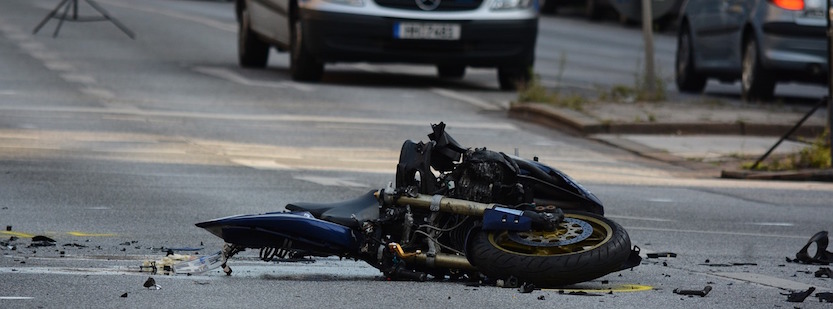Motorcyclist Tries to Pass Car in Wrong Lane, but Gets Swiped. Who’s At Fault?
When a motorcycle attempts to pass a vehicle by travelling in the wrong lane of travel and is side swiped by a vehicle they are passing, who is at fault?
In this week’s personal injury post, we wish to highlight the fact that liability assessments are often complicated and nuanced decisions that require considering the facts of the case carefully. In Postic v Demarco, 2020 BCSC 1950, a 2020 decision of D. MacDonald J., the court found split liability between a driver of a vehicle travelling east who struck the plaintiff motorcyclist that was trying to pass on the left. In this case, the plaintiff was travelling down Stewart Street in Vancouver and arrived at a line of vehicles. He came to a stop in the left most lane. He leaned over the centre line, saw that it was clear, and proceeded to cross over the centre line and drive down the road. As he was driving the wrong way, he came upon the defendant’s vehicle.
The defendant’s vehicle (a Nissan Pathfinder) gave no indication of turning or moving into the lane the plaintiff was travelling. The defendant testified that he decided to move into the oncoming lane to find out what was the reason for the backup in traffic. He testified that before he moved his vehicle, he checked his side and rear view mirrors as he routinely does. He also testified that it was his common practice to shoulder check but he could not recall if he in fact shoulder checked. His testimony was that he crept over the centre line a very low speed and he probably did not turn on his signal light.
As he crept over the line, the plaintiff collided with the defendant’s vehicle causing him to fly over the hood of the vehicle. MacDonald J. was tasked with figuring out who was liable and, if both parties were partially at fault, the split in liability.
Principles of Fault in Negligence and Contributory
In evaluating whether a plaintiff or defendant are negligent, courts must first consider the principles and obligations found in the legislation on the matter. In this case, MacDonald J. cited the relevant principles as follows:
[29] Pursuant to s. 4 of the Negligence Act, R.S.B.C. 1996, c. 333, if a plaintiff contributes negligently to their own injury, a court must determine the relative degrees of fault between the plaintiff and the defendant. The question is whether the plaintiff failed to take reasonable care for their safety and whether that failure was one of the causes of the accident: Bradley v. Bath, 2010 BCCA 10 at para. 27.
[30] A driver of a vehicle has the right to assume that another driver will obey the applicable traffic laws. Further, a driver has a duty to meet the standard of care imposed both at common law and pursuant to the Motor Vehicle Act, R.S.B.C. 1996, c. 318 [MVA]: Stewart v. Dueck, 2012 BCSC 1729 at paras. 37–41; Salaam v. Abramovic, 2010 BCCA 212 at paras. 18–21, 25–29.
[…]
[33] Both an overtaking and overtaken driver have an obligation to proceed in a reasonable and safe manner. In Eccleston v. Dresen, 2009 BCSC 332, Justice Barrow explained that there is no dominant and servient driver in an overtaking situation. Their “respective obligations are to be assessed in relation to the circumstances they faced and within that assessment the question of who had the better opportunity to avoid the collision is relevant”: at para. 26.
[34] A relevant consideration is which driver had the better opportunity to see the potential for a collision before it occurred. The driver with the better opportunity to see the potential for a collision has a correspondingly greater opportunity to avoid it: Samograd v. Collison (1995), 17 B.C.L.R. (3d) 51 at paras. 60–63, 67 B.C.A.C. 223; Ekman at para. 62.
[35] Another aspect of the test for negligence is whether a collision is reasonably foreseeable. The fact that something is possible does not mean that it is reasonably foreseeable. As the Supreme Court of Canada points out, any harm that has occurred was by definition possible. For harm to be reasonably foreseeable, a higher threshold than mere possibility must be met: Rankin (Rankin’s Garage & Sales) v. J.J., 2018 SCC 19 at para. 46.
[36] The principles relating to the assessment of credibility were helpfully reviewed by Justice Dillon in Bradshaw v. Stenner, 2010 BCSC 1398 at paras. 186–187, aff’d 2012 BCCA 296. Justice Dillon refers to the well-known test in Faryna v. Chorny (1951), [1952] 2 D.L.R. 354, [1952] W.W.R. 171 (B.C.C.A). The Court of Appeal in Faryna held that the evidence of each witness must be tested against its harmony with other evidence, the preponderance of the probabilities, and with its reasonableness.

Was the plaintiff found at fault?
Yes, the plaintiff was found partially at fault. MacDonald J. found that the plaintiff was going to be late for work and he was in a hurry to get to work. Rather than waiting in the traffic as a reasonable person would have done, the plaintiff chose to cross the centre line and travel down the road. Further, the plaintiff did not keep a safe distance when passing other vehicles and was passing other vehicles on the left when it was not safe to do so, namely in the lane designed for the opposite direction of travel.
As such, the plaintiff found at fault for the collision. This conclusion seems unassailable at law.
Was the defendant found at fault?
With respect to the defendant, it becomes interesting. We have two parties both pulling into the opposite lane of travel who have a collision. MacDonald J. found that the defendant was also negligent and in fact more at fault than the plaintiff. MacDonald J. came to this conclusion as follows:
[55] The Ising report confirms Mr. Demarco’s evidence that he was moving very slowly as he pulled into the eastbound lane. There is no evidence to suggest that Mr. Demarco was attempting to make a U-turn. However, Mr. Demarco did not activate his turn signal before pulling across the yellow line, contrary to s. 170 of the MVA. This was negligent in the circumstances.
[56] Mr. Demarco argues that whether or not he signaled would have made no difference because the plaintiff’s view of the Pathfinder was blocked until he was relatively close behind the Pathfinder. I disagree. A failure to see a vehicle does not excuse a driver from the obligation to be aware of vehicles around him: Brook v. Tod Estate, 2012 BCSC 1947 at para. 23, aff’d 2013 BCCA 503.
[57] Although Mr. Postic would not have seen the signal until he was almost upon the Pathfinder, he might have had time to properly brake or to swerve to the left to avoid the collision. Mr. Ising reported that Mr. Postic took evasive action by braking quickly, in less than 1.1 seconds, in response to seeing the Pathfinder. Mr. Postic’s reaction time was good.
[58] I agree with Mr. Postic that Pipe v. Dusome, 2007 BCSC 1066, and Crevier v. Thompson, 2015 BCSC 1552, both relied upon by the defendant, can be distinguished on their facts. In those cases, both drivers were travelling in the same direction and the overtaking driver had noticed the turning driver slowing down, but did not take steps to confirm the turning driver’s intention (i.e., that they were going to turn left rather than right) before overtaking them. In contrast, Mr. Demarco was fully stopped in his lane without his left turn signal on. He gave no indication that he was about to turn (such as slowing down). Mr. Postic could not have known Mr. Demarco was about to turn into the lane ahead of him.
[59] Mr. Demarco also did not shoulder check prior to turning left into the eastbound lane. This is contrary to s. 166(c) of the MVA, in that Mr. Demarco did not ascertain that his turn could be made safely, with regard to the use of the road and the driving conditions. Passing was permitted on this section of Stewart Street. Mr. Demarco did not take reasonable precautions by shoulder checking and signalling prior to pulling into the eastbound lane. I find he was negligent in the circumstances.
[60] While both parties were negligent, I find that Mr. Demarco’s negligence was greater in the circumstances. I agree with Barrow J’s conclusion in Eccleston:
[46] I find that the negligence of both drivers was significant. I am of the view that the plaintiff’s negligence was greater than that of the defendant in that failing to signal in a timely way, and failing to keep a proper look out when turning left off of a highway at a point where passing is permitted, is significantly negligent. …
[61] I find both parties were at fault for contributing to the accident. Neither was a dominant driver and both parties had an opportunity to see the potential for a collision before it occurred: [citations omitted]. By not doing so, both parties were negligent.
[62] Mr. Postic should not have pulled out because the wide-load truck was in the eastbound lane. Assuming it was safe to pull out, which it was not, Mr. Postic was overtaking stopped vehicles and it was foreseeable that other vehicles would have the same idea. He should have proceeded at a lower speed and moved further to the centre lane so that he could have been more easily seen and could have more easily taken evasive maneuvers, if necessary.
[63] Mr. Demarco would likely have seen the motorcycle had he shoulder checked. Further, he would have provided Mr. Postic with warning had he activated his left signal.
[64] Mr. Demarco’s negligence was greater than Mr. Postic’s by failing to shoulder check before pulling into the oncoming lane and failing to signal before turning from a stopped position. He gave Mr. Postic no warning of his intention to turn.
[65] I find that the defendant is 70% liable for the collision and the plaintiff is 30% liable for the collision. Liability is so apportioned.
In this case, the court found that the defendant’s failure to check if other vehicles were passing on the left beyond the centre line was more blameworthy than the plaintiff travelling in the wrong lane of travel. It will be interesting to see if this finding is appealed but this case serves as a useful illustration that levels of fault and blameworthiness for accidents are not always clear, and it takes an appreciation of all the facts before a decision can be made.
Book A Consultation
If you have been injured in a car accident, then you should not immediately accept the determinations of liability by an insurance company or your own first thoughts. It is important to get legal advice. Contact us and we can help you evaluate whether you have a viable claim that can be made despite potential for a negative liability finding.



